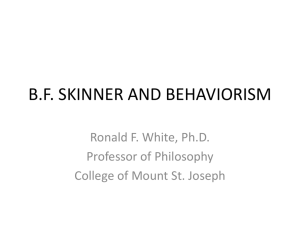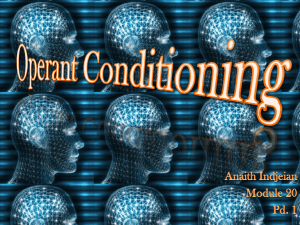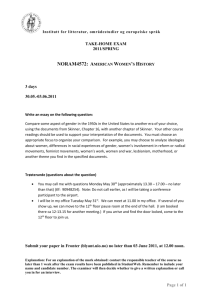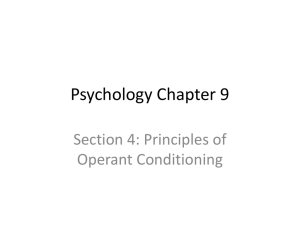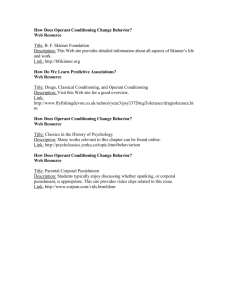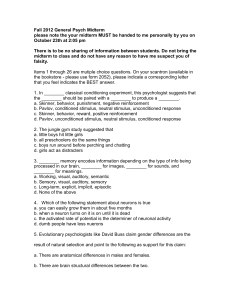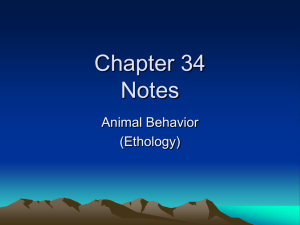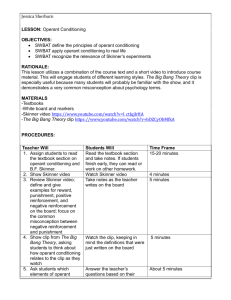BF Skinner
advertisement
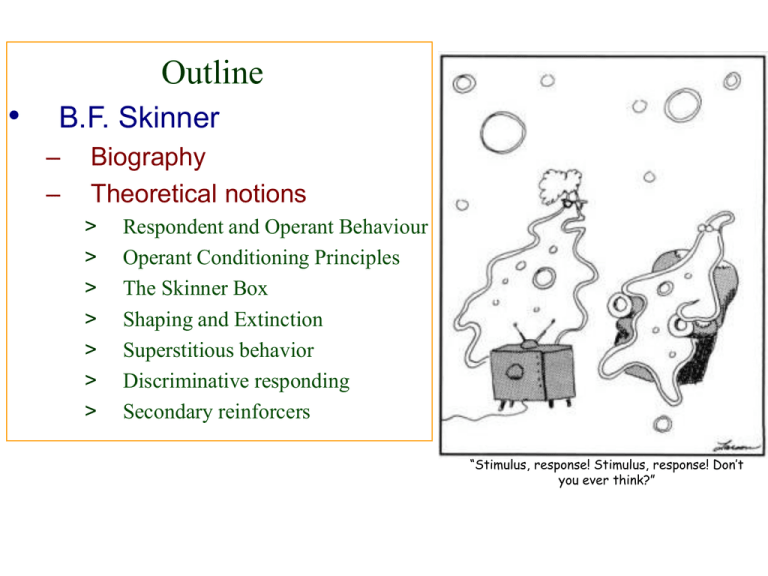
Outline • B.F. Skinner – – Biography Theoretical notions > > > > > > > Respondent and Operant Behaviour Operant Conditioning Principles The Skinner Box Shaping and Extinction Superstitious behavior Discriminative responding Secondary reinforcers “Stimulus, response! Stimulus, response! Don’t you ever think?” B. F. Skinner • Biography B. F. Skinner (1904-1990) – Wanted to be writer >B.A. in English Literature (1926) – Entered graduate school at Havard (1928) >Mentored by the Chair of Physiology (W. Crozier) Who studied the “animal as a whole” without appealing to internal processes. >Obtained his Ph.D. in 1931 – Taught at University of Minnesota (1936 - 1945) >Published “The Behaviour of Organisms” (1938) – Affiliated with Havard until he died (1990) B. F. Skinner • Biography – Inventions > The air-crib B. F. Skinner (1904-1990) Easily-cleaned, temperature and humidity-controlled Somewhat controversial (but effective) Commercially manufactured >Project pigeon Received a 25K grant to develop a cruise missile • Guided by trained pigeons • U.S. Navy passed on it (but retested the idea in the 1980s) B. F. Skinner • Biography – Inventions B. F. Skinner (1904-1990) > The Skinner Box (AKA, operant chamber) Animal can respond multiple times Operant response: Bar pressing Operant conditioning: Increased bar pressing when food is delivered following the response. B. F. Skinner • Biography – Inventions B. F. Skinner (1904-1990) > Cumulative recorder Keeps track of the animal’s responding • Time is recorded on the ‘X’ axis • Total number of responses is recorded on the ‘Y’ axis • Faster rates of responding lead to steeper slopes B. F. Skinner • Major Theoretical Notions – Respondent and operant behaviour B. F. Skinner (1904-1990) >Respondent behaviour - Behaviour elicited by a known stimulus E.g., Unconditioned responses • Elicited by unconditioned stimuli • Reflexive >Operant behaviour - Behaviour not elicited by a known stimulus E.g., Most of our everyday behaviour • Occurs spontaneously B. F. Skinner • Major Theoretical Notions – Type S and Type R conditioning > Two kinds of conditioning B. F. Skinner (1904-1990) Type S (respondent conditioning) - classical (Pavlovian) conditioning • ‘S’ to emphasize the role of the eliciting Stimulus • Strength is measured by the magnitude of the CR Type R (operant conditioning) - learning that involves operant behaviour • ‘R’ to emphasize Response • Strength is measured by the response rate B. F. Skinner • Major Theoretical Notions B. F. Skinner (1904-1990) – Type S and Type R conditioning > Comparison with Thorndike’s approach Thorndike’s puzzle box • Dependent variable was time-to-solution -> I.e., how long it took to learn a (single) response Skinner • Dependent variable was rate of responding -> I.e., What variables affect the rate of responding Edward Lee Thorndike (1874 - 1949) B. F. Skinner • Major Theoretical Notions – Operant conditioning principles B. F. Skinner (1904-1990) >Two general principles Any response that is followed by a reinforcing stimulus tends to be repeated A reinforcing stimulus is anything that increases the rate with which an operant response occurs • I.e., anything that increases the probability of a response’s re-occurring B. F. Skinner • Major Theoretical Notions – Operant conditioning principles B. F. Skinner (1904-1990) >Contingent reinforcement Emphasis on behaviour and its consequences • Gaining reinforcement depends (i.e., is contigent) on making the appropriate response Culture as a set of reinforcement contigencies • Different cultures reinforce different behaviour patterns Controlling reinforcement -> controls behaviour • E.g, child rearing B. F. Skinner • Major Theoretical Notions B. F. Skinner (1904-1990) – Conditioning the lever-pressing response >Three steps 1. Deprivation • Food/water deprived for 23 hours per day • Animal is held at 80% of its free-feeding body weight 2. Magazine training • Food pellets are delivered by the experimenter • Animal learns to associate the sound of the delivery mechanism with food B. F. Skinner • Major Theoretical Notions B. F. Skinner (1904-1990) – Conditioning the lever-pressing response >Three steps 3. Lever pressing • Animal is placed in the box • Eventually hits the lever (operant response) • Delivery of food pellet reinforces the response. B. F. Skinner • Major Theoretical Notions B. F. Skinner (1904-1990) – Conditioning the lever-pressing response >Shaping A faster method of teaching the rat to lever press Two components 1. Differential reinforcement -> Some responses are reinforced, others are not 2. Successive approximations -> Only reinforce responses that become progressively closer to the desired response B. F. Skinner • Major Theoretical Notions – Extinction and spontaneous recovery B. F. Skinner (1904-1990) >Extinction - removing the reinforcer removes the operant response >Spontaneous recovery - The reoccurrence of a Rest Cumulative responses response that had been extinguished, with no additional training. Extinction Time Spontaneous recovery B. F. Skinner • Major Theoretical Notions – Superstitious behavior B. F. Skinner (1904-1990) >What if we delivered pellets noncontingently? Random behaviour would get reinforced • E.g., Dog running in circles while waiting to get fed Humans are susceptible to similar conditioning • E.g., Athletes/ coaches’ game rituals B. F. Skinner • Major Theoretical Notions – Discriminative operant B. F. Skinner (1904-1990) >Skinner box is set so that reinforcement is only available when the light is on. The light is the discriminative stimulus • I.e., indicates that reinforcement is available SD = light on, SD = light off, SR = reinforcing stimulus • A discriminative operant is symbolized as: SD -> R -> SR • Skinner was interested in the SD -> R association -> Cf. respondent conditioning Stimulus control of behaviour B. F. Skinner • Major Theoretical Notions – Secondary reinforcement B. F. Skinner (1904-1990) >A neutral stimulus paired with a reinforcer can take on reinforcing qualities of its own >To test this notion Lever press -> light -> food Extinguish the response • Neither light nor food is delivered Allow lever - press to deliver light (not food) • Response rate increases B. F. Skinner • Major Theoretical Notions – Secondary reinforcement B. F. Skinner (1904-1990) >A secondary reinforcer can be used to reinforce other responses Clicker training for dogs • Warning: secondary reinforcers can be extinguished! Money for humans • Generalized reinforcer
